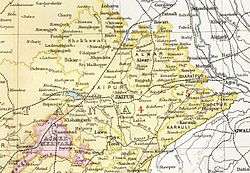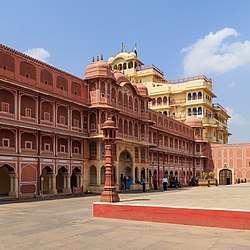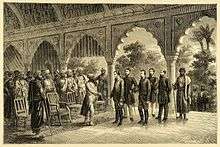Jaipur State
Jaipur State, historically known as the Kingdom of Amber, was a kingdom of India, centred on Jaipur town and later a princely state during the British period. It existed from the 12th century and was in a subsidiary alliance with the British from 1818 until their withdrawal from India in August 1947. It was then fully independent until its ruler acceded to India in April 1949, and retained some internal self-government for a period after that.
Kingdom of Jaipur Jaipur State | |||||||
|---|---|---|---|---|---|---|---|
| 1128–1949 | |||||||
.svg.png) Flag (c. 1699–1818)
 Coat of arms
| |||||||
 Jaipur State in the Imperial Gazetteer of India | |||||||
| Capital | Jaipur | ||||||
| Common languages | Dhundari, Hindi, Sanskrit | ||||||
| Government | Monarchy (1128–1818; 1947–1949) Princely state (1818–1947) | ||||||
| Maharaja Sawai | |||||||
• 1128 | Dūlaha Rāya (first) | ||||||
• 1922–1949 | Man Singh II (last) | ||||||
| History | |||||||
• Established | 1128 | ||||||
• Acceded to India | 1949 | ||||||
| Area | |||||||
| 1931 | 40,407 km2 (15,601 sq mi) | ||||||
| Population | |||||||
• 1931 | 2,631,775 | ||||||
| Currency | Indian Rupee | ||||||
| |||||||
| Today part of | Rajasthan, Republic of India | ||||||



History
Jaipur's predecessor state was the kingdom of Dhundhar or Dausa, founded in 1093 by Dullah Rai, also known as Dulha Rao. The state was known as Amber between the fourteenth century and 1727. In that year, a new capital was built and named Jayapura, when the kingdom was renamed as Jaipur.[1]
Dhundhar Kingdom
The Kachwahas claim descent from Kusha, son of the legendary Rama. Their ancestors allegedly migrated from Rama's kingdom of Kosala and established a new dynasty at Gwalior.[2] After 31 generations, they moved to Rajputana and created a kingdom at Dhundhar. Dullah Rai, one of the ancestors of the Kachwaha rulers, defeated the Meenas of Manchi and Amber and later completed the conquest of Dhundhar by defeating the Bargurjars of Dausa and Deoti.[3]
Amber Kingdom
The rulers of Amber fought as generals in the army of Prithviraj Chauhan and later under the banner of Rana Sanga against the Mughals under Babur. The small kingdom of Amber was later conquered by Maldev Rathore and became feudatories of Marwar until the 16th century, Bharmal Kachwaha, sought alliance with Akbar to gain his political and military support against the Rathores of Marwar and his own divided clansmen.[4][5] He was formally recognised as a Raja by the Mughals and was invested into the Mughal nobility in return for his daughter's marriage to Emperor Akbar. Raja Bharmal's daughter, Mariam-uz-Zamani, who married Akbar, later became the mother of the fourth Mughal emperor Jahangir. She gained prestige in the Mughal court both during the reign of her husband and that of her son as Empress and Queen mother respectively. By this relation, the Rajas of Amer also gained significant prominence in the Mughal court.
A governor was appointed to oversee Bharmal's territory and a tribute arrangement saw Bharmal given a salaried rank, paid for from a share of the area's revenue.[6][7]
The ruling dynasty of Amber prospered under Mughal rule and provided the Mughal Empire with some distinguished generals.[8] Among them were Bhagwant Das, Man Singh I, who fought and governed from Kabul to Orissa and Assam and Jai Singh I.[8]
Jaipur Kingdom
Jai Singh I was succeeded by Ram Singh I, Bishan Singh and Jai Singh II. Jai Singh II, also known as Sawai Jai Singh, ruled the state from 1699 to 1743 and was a famous mathematician and astronomer. During his rule, the new capital city of Jaipur was founded.[8] in 1727.
Throughout the disintegration of the Mughal Empire, the armies of Jaipur were in a constant state of warfare. Towards the end of the 18th century, the Jats of Bharatpur and the Kachwaha chief of Alwar declared themselves independent from Jaipur and each annexed the eastern portion of Jaipur's territory.[8] This period of Jaipur's history is characterised by internal power-struggles and constant military conflicts with the Marathas, Jats, other Rajput states, as well as the British and the Pindaris. Jaipur suffered against the Rathors of Marwar in the Battle of Gangwana with appalling losses.[9] The kingdom again suffered a disastrous defeat at the hands of the Maratha forces of Mahadji Scindia in the Battle of Patan in 1790, forcing the rulers of Jaipur to pay heavy tributes.[10] Nevertheless, enough wealth remained in Jaipur for the patronage of fine temples/palaces, continuity of its courtly traditions and the well-being of its citizens and merchant communities. Jaipurs last attempt to gain freedom from Gwalior ended in a defeat at the Battle of Malpura.[11] A treaty was initially made by Maharaja Sawai Jagat Singh and the British under Governor General Marquis Wellesley in 1803, however the treaty was dissolved shortly afterwards by Wellesley's successor, Lord Cornwallis. In this event, Jaipur's Ambassador to Lord Lake observed that "This was the first time, since the English government was established in India, that it had been known to make its faith subservient to its convenience".[12]
In 1818 Jaipur became a British protectorate by entering into a subsidiary alliance. In 1835 there was a serious disturbance in the city because of a false rumour that the British had murdered the infant raja to ensure the annexation[13], after which the British government intervened.[8] The state later became well-governed and prosperous.[8] During the Indian rebellion of 1857, when the British invoked the treaty to request assistance in the suppression of rebellious sepoys, the Maharaja opted to preserve his treaty, and thus sent in troops to help to subdue the uprisings[8] in the area around Gurgaon.
Jaipur state had a revenue of Rs.65,00,000 in 1901, making it the wealthiest Princely state in Rajputana.[14]
Jaipur's last princely ruler signed the accession to the Indian Union on 7 April 1949.
In 2019, titular Maharaja Padmanabh Singh (born 12 July 1998), full title Maharaja Sawai Padmanabh Singh of Jaipur, is the young monarch of Jaipur, a city in northwestern India famous for its pink architecture and imperial palaces. Estimates of the royal family's wealth vary, but Singh is estimated to control a fortune of between $697 million and $2.8 billion.
Ruling dynasty
Rulers
- 27 Dec 966 – 15 Dec 1006 Sorha Deva (d. 1006)
- 15 Dec 1006 – 28 Nov 1036 Dullah Rai (d. 1036)
- 28 Nov 1036 – 20 Apr 1039 Kakil (d. 1039)
- 21 Apr 1039 – 28 Oct 1053 Hanu (d. 1053)
- 28 Oct 1053 – 21 Mar 1070 Janddeo (d. 1070)
- 22 Mar 1070 – 20 May 1094 Pajjun Rai (d. 1094)
- 20 May 1094 – 15 Feb 1146 Malayasi (d. 1146)
- 15 Feb 1146 – 25 Jul 1179 Vijaldeo (d. 1179)
- 25 Jul 1179 – 16 Dec 1216 Rajdeo (d. 1216)
- 16 Dec 1216 – 18 Oct 1276 Kilhan (d. 1276)
- 18 Oct 1276 – 23 Jan 1317 Kuntal (d. 1317)
- 23 Jan 1317 – 6 Nov 1366 Jonsi (d. 1366)
- 6 Nov 1366 – 11 Feb 1388 Udaikarn (d. 1388)
- 11 Feb 1388 – 16 Aug 1428 Narsingh (d. 1428)
- 16 Aug 1428 – 20 Sep 1439 Banbir (d. 1439)
- 20 Sep 1439 – 10 Dec 1467 Udharn (d. 1467)
- 10 Dec 1467 – 17 Jan 1503 Chandrasen (d. 1503)
- 17 Jan 1503 – 4 Nov 1527 Prithviraj Singh I (d. 1527)
- 4 Nov 1527 – 19 Jan 1534 Puranmal (d. 1534)
- 19 Jan 1534 – 22 Jul 1537 Bhim Singh (d. 1537)
- 22 Jul 1537 – 15 May 1548 Ratan Singh (d. 1548)
- 15 May 1548 – 1 June 1548 Askaran (d. 1599)
- 1 June 1548 – 27 Jan 1574 Bharmal (d. 1574)
- 27 Jan 1574 – 4 Dec 1589 Bhagwant Das (b. 1527 – d. 1589)
- 4 Dec 1589 – 6 Jul 1614 Man Singh (b. 1550 – d. 1614)
- 6 Jul 1614 – 13 Dec 1621 Bhau Singh (d. 1621)
- 13 Dec 1621 – 28 Aug 1667 Jai Singh I (b. 1611 – d. 1667)
- 10 Sep 1667 – 30 Apr 1688: Ram Singh I (b. 1640 – d. 1688)
- 30 Apr 1688 – 19 Dec 1699: Bishan Singh (b. 1672 – d. 1699)
- 19 Dec 1699 – 21 September 1743: Jai Singh II (b. 1688 – d. 1743)
- 1743 – 12 December 1750: Ishwari Singh (b. 1721 – d. 1750)
- 1750 – 5 March 1768: Madho Singh I (b. 1728 – d. 1768)
- 1768 – 13 April 1778: Prithvi Singh II (b. c. 1762 – d. 1778)
- 1778 – 1803: Pratap Singh (b. 1764 – d. 1803)
- 1803 – 21 November 1818: Jagat Singh II (b. ... – d. 1818)
- 22 December 1818 – 25 April 1819: Mohan Singh (regent) (b. c. 1809 – d. ...)
- 25 April 1819 – 6 February 1835: Jai Singh III (b. 1819 – d. 1835)
- Feb 1835 – 18 September 1880: Ram Singh II (b. 1835 – d. 1880)
- 18 September 1880 – 7 September 1922: Madho Singh II (b. 1861 – d. 1922)
- 7 September 1922 – 15 August 1947 (subsidiary): Sawai Man Singh II (b. 1912 – d. 1970)
- 15 August 1947 – 7 April 1949 (independent): Sawai Man Singh II (b. 1912 – d. 1970)
Titular rulers
- 7 April 1949 – 24 June 1970: Sawai Man Singh II
- 24 June 1970 – 28 December 1971: Sawai Bhawani Singh (b. 1931 – d. 2011)
Ceremonial rulers
- 28 December 1971 – 17 April 2011: Sawai Bhawani Singh (b. 1931 – d. 2011)
- 17 April 2011 – present: Padmanabh Singh (b. 1998)
Other family members
Jaipur Residency
The Jaipur Residency was established in 1821. It included the states of Jaipur, Kishangarh and Lawa. The latter had belonged to the Haraoti-Tonk Agency until 1867.[17]
See also
References
- Princely States of India
- Prasad, Rajiva Nain (1966). Raja Man Singh of Amber. pp. 1.CS1 maint: ref=harv (link)
- Sarkar, Jadunath (1984). A History of Jaipur: C. 1503–1938. Orient Longman Limited. pp. 23–23. ISBN 81-250-0333-9.CS1 maint: ref=harv (link)
- Arms & Armour at the Jaipur court by Robert Elgood p.10
- Sarkar (1994, p. 34)
- Wadley, Susan Snow (2004). Raja Nal and the Goddess: The North Indian Epic Dhola in Performance. Indiana University Press. pp. 110–111. ISBN 9780253217240.
- Sadasivan, Balaji (2011). The Dancing Girl: A History of Early India. Institute of Southeast Asian Studies. pp. 233–234. ISBN 9789814311670.
- Chisholm, Hugh, ed. (1911). . Encyclopædia Britannica. 15 (11th ed.). Cambridge University Press. pp. 128–129.
- Sarker (1994, p. 209)
- Sarker (1994, p. 289)
- Sarker (1994, p. 315)
- Giles Tillotson, Jaipur Nama: Tales from the Pink City.
- Rajasthan Through the Ages By R.K. Gupta, S.R. Bakshi, pg.287
- https://dsal.uchicago.edu/reference/gazetteer/pager.html?objectid=DS405.1.I34_V13_401.gif
- Prasad (1966, pp. 1–3)
- Sarker (1994)
- Imperial Gazetteer of India, v. 16, p. 156.
| Wikimedia Commons has media related to Jaipur State. |